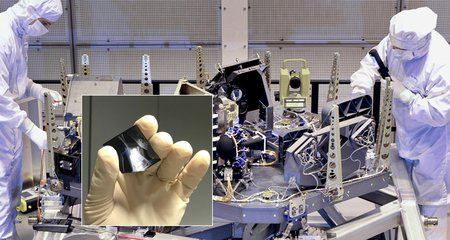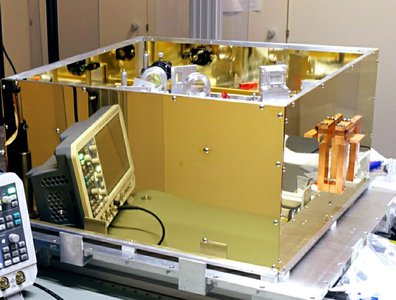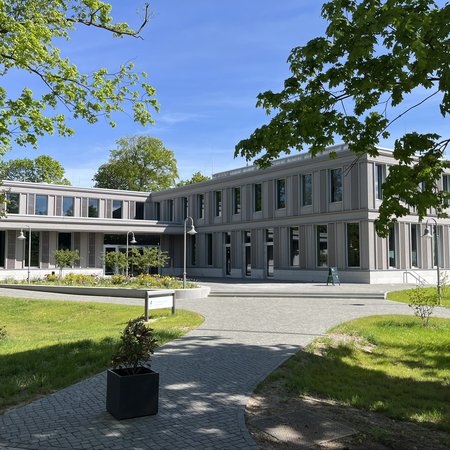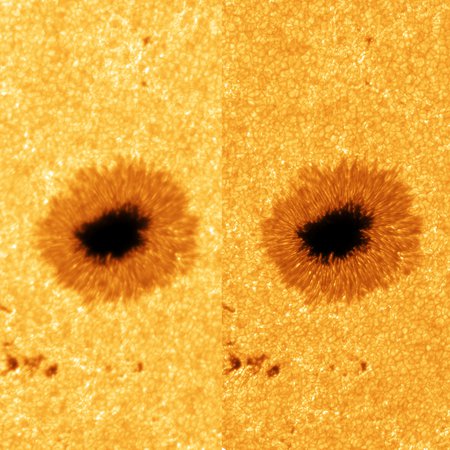EU funding of 3,4 million euros for the PICS4SENS project

Integrated photonic „spectrograph on a chip“. For size comparison, in the background the near-infrared spectrograph NIRspec for the James Webb Space Telescope during integration at the manufacturer.
Credit: Astrium, AIPThe joint project PICS4SENS by the Leibniz Institutes AIP and IHP in cooperation with the innoFSPEC transfer laboratory at the University of Potsdam won the competition in last year's StaF call for proposals and will be funded over a period of four years with a total of 3,4 million euros, 2.2 million euros of which will go to the AIP.
The StaF-Verbund funding programme to promote the strengthening of technological and application-oriented research in research networks of scientific institutions in the state of Brandenburg is financed by the European Regional Development Fund (ERDF). PICS4SENS will help to increase the technological maturity and shorten the path to commercialisation of photonic integrated circuits in sensor technology.
These somewhat unwieldy terms can be summarised in a short sentence: the development of a spectrograph 'on-a-chip'. This picture gives an idea of what is involved: the realisation of what are traditionally large and expensive high-performance optics in a tiny photonic chip.
Photonics is a modern technology in which the conduction of light (photons in waveguides) is utilised in a similar way to electronics, which is based on the conduction of electric current (electrons in semiconductors). Just as electronic chips are now ubiquitous in computers, smartphones and cars, the industry is working at top speed to develop photonic integrated circuits (PICs): a rapidly growing future market according to current market analyses. PICs have already established themselves in computer centres and Internet data communication. Another area of application is still in its infancy: spectroscopy and sensor technology.
The scientists in the AIP's Astrophotonics section, led by Dr. Kalaga Madhav, have achieved a leading international position in this field and have developed and utilised various generations of PICs for applications in spectroscopy and interferometry. With a chip of the type shown in the picture, a spectrograph designed for the near-infrared range was built for the first time in the world with the support of AIP research technology: PAWS, the "Potsdam Arrayed Waveguide Spectrograph". Here, a highly sensitive image sensor is cooled to a temperature of –190 °C in order to electronically record the chip's high-resolution spectrum.
The rather bulky design of the cooling housing for the infrared image sensor compared to the chip shows that miniaturisation has not yet been fully achieved. This is precisely where the PICS4SENS project comes in: The Leibniz Institute for Innovative Microelectronics (IHP) has all the prerequisites and expertise to integrate the image sensor into the PIC, a marriage of photonics and electronics, so to speak.
Researchers hope that this will not only lead to a breakthrough for astrophysical instruments, particularly in space, but also to outstanding innovation potential and future market opportunities in areas such as agricultural technology, mobility, healthcare, food technology and chemistry – future topics that have been prioritised by the 'innoBB2025 plus' innovation strategy and the master plan for the optics and photonics cluster in Berlin and Brandenburg.
Project manager Martin Roth emphasises: "With the Leibniz Institute for Innovative Microelectronics (IHP) in Frankfurt (Oder) and the Leibniz Institute for Astrophysics Potsdam (AIP), the state of Brandenburg has two top performers in top international research, according to the latest evaluations by the Leibniz Association. In cooperation with the innoFSPEC transfer laboratory at the University of Potsdam, the PICS4SENS project has excellent prerequisites for further expanding and utilising our technological lead."
Further information
Astrophotonics at AIP: https://www.aip.de/de/research/astrophotonics/
innoFSPEC transfer lab: https://innofspec.de/en/transfer-lab
Optics cluster Berlin Brandenburg: https://www.optik-bb.de/
Images
Integrated photonic „spectrograph on a chip“. For size comparison, in the background the near-infrared spectrograph NIRspec for the James Webb Space Telescope during integration at the manufacturer.
Big screen size [1000 x 534, 140 KB]
Original size [2880 x 1540, 680 KB]
The near-infrared spectrograph PAWS (Potsdam Arrayed Waveguide Spectrograph) which is based on the chip shown in the other picture. The gold-plated surfaces serve as a radiation shield for the near-infrared image sensor and comprise a cooling housing with a volume of about 1m x 1m x 0.4m, which is significantly larger than the chip size. The project PICS4SENS aims at integrating the image sensor into the chip.




